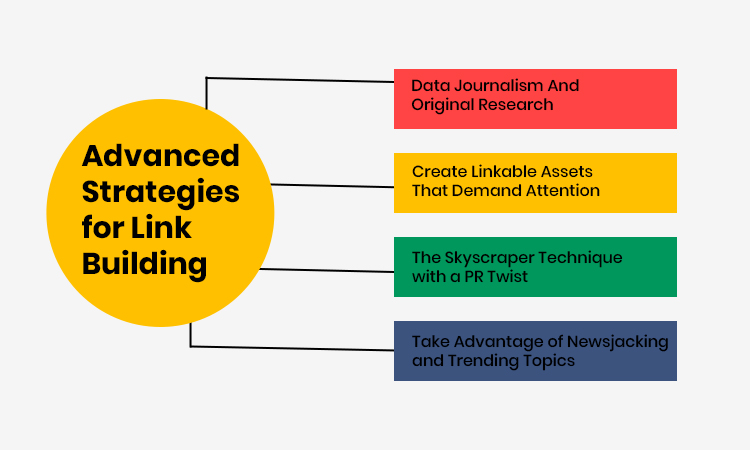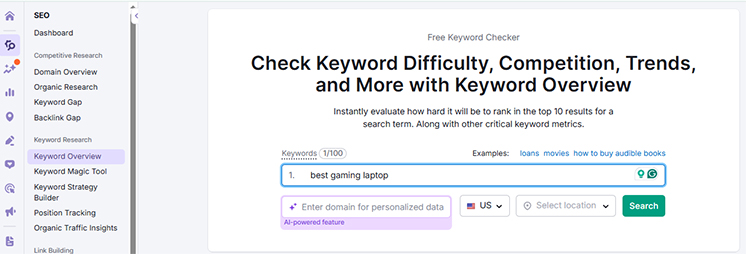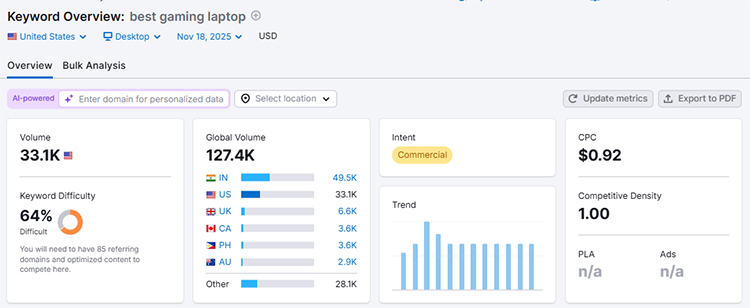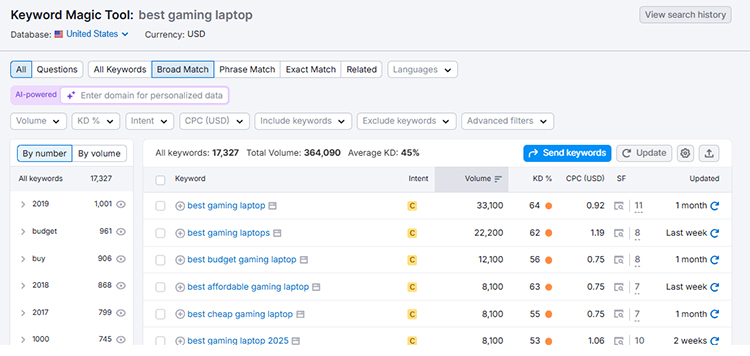You may think search engine optimization (SEO) and public relations (PR) may be different, but somehow both disciplines strategize for the same outcome. It will uplift your business’s online presence and improve your online reputation. SEO and PR have their own unique practices and strategies, but when you combine both perfectly, they can give you powerful results for your company.
Search engines have a big impact on over 90% of online experiences, so SEO is the most important part of digital marketing. Moreover, PR can help promote your brand’s message and reach a wider audience through media coverage and influencer partnerships.
The worldwide SEO software market was worth USD 74.6 billion in 2024 and is expected to reach USD 154.6 billion by 2030, increasing 13.5% from 2025 to 2030. Furthermore, the worldwide public relations tools market was valued at USD 6.35 billion in 2023 and is expected to reach USD 13.33 billion by 2030, with a CAGR of 10.9% between 2024 and 2030. To create a good relationship between the company and its clients, public relations (PR) is the best tool to establish connections with institutions or public organizations. So let’s explore how you can combine SEO and PR to create a strong digital marketing strategy that improves your online brand visibility and authority across various platforms.
What is SEO and PR?

Search engine optimization(SEO) is one of the most powerful techniques of digital marketing campaigns. It helps your website to rank higher in search engine rankings.
Key SEO Components:
- Technical optimization ensures search engines can crawl and index your site
- On-page elements like keywords, meta tags, and content structure matter significantly
- Off-page factors, including backlinks, signal your website’s authority to Google
- User experience metrics like page speed affect your search rankings directly
- Local optimization helps businesses appear in geographically relevant searches
PR (Public Relations) manages how your brand communicates with audiences and media outlets. Your reputation depends on strategic storytelling across various channels and platforms. The discipline focuses on earning media coverage rather than purchasing advertising space. Your brand perception improves through consistent, credible third-party endorsements and mentions.
Key PR Components:
- Media relations build connections with journalists who cover your industry niche.
- Press releases announce newsworthy developments to relevant media contacts strategically.
- Thought leadership positions executives as authoritative voices in their fields.
- Crisis management protects your reputation during challenging situations or negative events.
- Brand storytelling creates emotional connections between your company and audiences.
How Digital PR Fuels SEO?
The relationship between digital PR and SEO has become increasingly vital in modern digital marketing. When public relations professionals execute strategic PR campaigns, they create powerful opportunities to increase search engine rankings to improve your online reputation. This synergy between PR and SEO gives impactful results that traditional marketing alone cannot achieve. Here, you can explore the most important strategy that fuels SEO with Digital PR, from earning high-quality backlinks to increasing your brand mentions to expand your referral traffic.
- Earn High-Authority Backlinks

In the search engine optimization process, gaining high-quality backlinks is very important. It helps improve your search engine ranking in search engine results pages. When other reliable websites naturally link to your content because they think it’s valuable, reliable, or helpful, then you’re acquiring backlinks. These links act as “votes of confidence” that help search engines understand your authority, increase online prominence, and enhance ranking quality without paid promotion or link-exchange tactics. When public relations teams obtain media attention, they provide signals that search engines interpret as authority indications. This makes link-building a natural byproduct of effective public relations, with each campaign serving as a chance to promote rankings, legitimacy, and organic reach.
What Is Link Authority and Its Impact?
If you gain so many links that don’t give you more reach, but the quality of the backlinks can. Search engines rank links based on the source’s domain authority, compatibility with your industry, and editorial standards. A single link from a major industry publication can outweigh dozens from low-quality directories. Your SEO and PR strategy must prioritize quality over quantity, so you should emphasize publications that genuinely influence your target audience.
Advanced Strategies for Link Building

These advanced link-building methods utilize industry engagement, PR-driven outreach, and strategic content creation to secure high-authority backlinks. All of these methods help you get noticed in the competitive market, attract organic attention, and develop authority from original data research to interactive tools and newsjacking.
- Data Journalism and Original Research
- If you publish your own research, it can make your company look like an expert in the field and give reporters valuable content for stories.
- So you need to survey your customers, assess industry trends, or gather statistical data that reveal surprising patterns. Journalists constantly seek fresh data to support their articles, so you can develop them as natural partners for your PR campaigns.
- Platforms like Twitter and LinkedIn allow you to interact with journalists covering your industry. Your contributions to their discussions should demonstrate knowledge and helpfulness rather than self-promotion. When you eventually pitch a story, they’ll recognize your name and associate it with value rather than spam.
- For example, you can survey 1,000 industry professionals about upcoming challenges. After that, you can write a detailed report about what you found, including charts and infographics for visuals. You should emphasize to media companies that your data is unique and that it relates to current issues in the industry when pitching this research.
- Create Linkable Assets That Demand Attention
- Your content needs to offer something journalists and editors cannot find elsewhere. Original research consistently generates the most powerful backlinks because media professionals constantly search for fresh data to support their stories. You might commission surveys within your industry, analyze trends using proprietary data, or collaborate with universities on research projects.
- Interactive tools and calculators provide another compelling approach. Financial websites that offer mortgage calculators or marketing platforms with ROI estimators naturally attract links because other sites reference these utilities when discussing related topics. The investment in developing these resources pays dividends through sustained link acquisition over months or years.
- Visual content deserves special attention in your digital PR arsenal. Many blogs and social media sites share detailed infographics that break down complicated data into easy-to-understand formats. To make it easy for others to give credit where credit is due, you should make sure that these images have integrated codes that automatically credit your website.
- The Skyscraper Technique with a PR Twist
- You need to find valuable content in your niche that has a lot of backlinks and then produce something significant. Your version should be more extensive, more current, or more visually engaging. However, integrating PR helps you to reach out to websites that linked to the original piece.
- Your outreach message should politely inform them that you’ve created an updated resource that might better serve their readers. This approach works because you’re offering genuine value rather than asking for favors. The key lies in ensuring your content truly surpasses the original—half-hearted attempts rarely succeed.
- Take Advantage of Newsjacking and Trending Topics
- Timing plays a critical role in earning authoritative backlinks. Your PR campaigns should monitor industry developments and breaking news that relate to your expertise. When relevant stories emerge, you can quickly create commentary or analysis that journalists need for their coverage.
- Moreover, you can use tools like Google Trends and social listening platforms to help you identify conversations gaining momentum. Your response must be both rapid and substantive—journalists working on deadline stories respect experts who can provide quotes or knowledge within hours rather than days.
- Increasing Brand Mentions and Signals
Search engine optimization extends beyond traditional backlinks. Search engines now rate brand mentions across the web, even without direct links. You can use entity recognition to improve your search engine rankings when publications mention your leadership team, products, or brand.
- Best Strategies:
- You can target publications where your target audience already spends time. A feature in a blog for a niche industry frequently generates more qualified traffic than coverage in the mainstream media.
- Then you may analyze your existing referral traffic using Google Analytics to identify which sources convert best, then prioritize similar outlets in future SEO and PR efforts.
- After that, you can develop exclusive landing pages for major PR campaigns. People who read press releases or articles about your brand should go to pages that are specifically customized to their interests. Your online reputation will improve with this method, which increases conversion rates.
- How-to Guide:
- You may use UTM parameters on all links within press releases and pitched articles. This tracking shows which PR efforts bring in the most valuable visitors. Then you need to review this data monthly to adjust your PR strategy accordingly.
- Use great media attention in new ways on your own outlets. You can share stories on social media, include them in email newsletters, and draw attention to quotes on your website. Each PR win is stronger because it spreads the word about you and enhances your authority.
- Monitor your referral traffic patterns using Google Analytics 4. Identify which publications send visitors who stay longest and convert most frequently. Double down on building relationships with these high-performing outlets.
- Essential Tools:
You can use Moz to keep an eye on your SEO, Prowly to handle your PR campaigns, and Google Search Console to keep an eye on your search profile. This package gives you a lot of information about how the work of your PR workers helps your SEO and helps your business grow.
How SEO Informs Digital PR?
The traditional boundaries between SEO and PR have dissolved in today’s digital landscape. Your PR teams can no longer craft campaigns in isolation from search data, just as your SEO team cannot ignore the power of strategic media outreach. When SEO and PR are combined, a powerful marketing strategy can produce far greater results than either discipline could on its own.
- Using keyword data to find story ideas
Your keyword research reveals exactly what your target audience searches for when they need solutions. These search queries represent genuine questions, concerns, and interests that people actively pursue. It can be the ideal starting point for public relations campaigns that naturally generate positive media coverage.
Here you can learn how to find out keywords using keyword tools and how to map them, which can be newsworthy, and also, you can resolve the content gap with various search data. This can help you create a successful PR campaign that resonates with your target audience and garners attention from the media.
- Mining Search Intent for Newsworthy Angles
What your target audience will type on Google—that will be your keywords. Your PR professionals should analyze these search trends to identify gaps in existing media coverage. You’ve got a chance to establish your brand as the authority when you find subjects that are producing a lot of searches but little high-quality content.
You can use tools like Semrush and Ahrefs to provide knowledge of trending searches within your industry. Your analysis should extend beyond simple keyword volumes to examine the questions people ask. Features like “People Also Ask” boxes reveal the specific information gaps your PR content can fill. This approach ensures your media outreach addresses topics that genuinely matter to your right audience.
Seasonal keyword trends offer particularly valuable opportunities for planning PR campaigns months. Your content teams can put together studies based on data or expert opinions that come out just at the right time as search interest grows. This strategic alignment means that journalists get your pitch right when they’re working on stories about those hot topics, which increases your chances of getting that important press hit.
- How Can You Research Keywords With Semrush Keyword Tool?
First, you need to go to “Keyword Magic Tool” and then put your main keywords like this-

Then it will show you a detailed keyword list where you need to find relevant keywords as per your website’s requirements.


How to Choose Serach Intent, Volume, KD, and CPC?
| Metric | Definition | How to Choose It (Tips) |
| Search Intent | The purpose behind a user’s search (what the user wants). | Match your content to what users expect. Choose intent (informational, commercial, transactional, navigational) based on your content goal. |
| Search Volume | The average number of times a keyword is searched per month. | You can select keywords with good volume and relevance. Avoid only high-volume terms—prioritize terms you can realistically rank for. |
| KD (Keyword Difficulty) | How hard it is to rank for a keyword due to competition. | For new websites: pick KD below 30. |
| CPC (Cost Per Click) | The amount advertisers pay when someone clicks on an ad for that keyword. | High CPC means high commercial value. Choose high CPC if your goal is conversions; choose low/medium CPC for awareness topics. |
- Transforming Search Data into Compelling Narratives
Your interpretation of raw keyword data may seem uninteresting, but it shows fascinating human stories. A sudden spike in searches related to remote work tools during specific months could anchor a PR campaign about workplace evolution. Your brand messaging should connect these search patterns to broader cultural trends that media outlets find irresistible.
The “versus” searches in your niche indicate comparison points that consumers care about deeply. Your PR efforts can create definitive comparison guides or research studies that media contacts reference when covering these topics. This strategy positions your brand at the center of important conversations while earning valuable content that includes optimized links naturally.
Local SEO data presents unique opportunities for geographically targeted PR working with regional media outlets. Your analysis might reveal that certain cities show disproportionate interest in specific topics. This intelligence allows PR teams to craft hyper-relevant pitches for local publications, increasing acceptance rates while building relationships with media contacts in key markets.
- Identify Content Gaps That Media Needs
Your competitor analysis through SEO tools reveals which topics dominate search rankings and which remain underserved. These gaps represent prime opportunities for your public relations efforts to create high-quality content that fills obvious voids. Journalists constantly seek fresh perspectives on established topics—your data-backed insights provide exactly what they need.
You can take help from the following tools to figure out the content gap –
- Ahrefs
- Semrush
- Moz
- Google Search Console
- BuzzSumo
- AnswerThePublic
- AlsoAsked
- SimilarWeb
- Surfer SEO
- MarketMuse
The search rankings for industry terms show you which publications currently dominate the conversation. Your understanding of these dominant players informs your PR best practices by revealing which angles have been exhausted and which remain unexplored. This intelligence prevents your team from pitching overdone stories while highlighting opportunities for genuinely novel approaches.
- Optimize Press Releases for Search
Your press releases serve dual purposes in modern integrated SEO strategies—they must satisfy both journalists seeking newsworthy content and search engines indexing information.
In this section, you will learn how press releases can support both SEO and PR goals. It clarifies how headlines, keywords, visuals, and distribution choices can affect your online prominence. Moreover, you can discover how you craft a well-optimized press release and perfect headlines. Ultimately, the goal is to increase brand awareness and drive traffic to your website.
- Craft Headlines That Serve Multiple Masters
- The headline of your press release needs to intrigue journalists while incorporating target keywords naturally.
- Your primary keyword should appear early in the title, but never at the expense of compelling language that captures attention.
- A headline like “Industry Leader Launches Revolutionary Tool” means nothing to search engines, while “New Project Management Software Reduces Team Communication Time by 40%” speaks to both human readers and Google’s algorithms.
- Your subheadlines provide additional opportunities to include related keywords while breaking up content for readability.
These elements help search engines understand the full context of your announcement while making the release more scannable for busy journalists.
- Strategic Keyword Placement Throughout the Body
- The opening paragraph of your press release should establish context with your primary keyword naturally. Your writing must prioritize clarity and newsworthiness—keyword stuffing destroys authenticity and readability. The most effective PR approach integrates keywords organically into genuinely informative content.
- Your use of synonyms and related terms throughout the release helps search engines understand topic relevance without repetitive language that feels robotic. This semantic approach aligns with how Google’s algorithms have evolved to understand context rather than just matching exact phrases. The result is more engaging content that performs well in both SEO performance metrics and journalist reception.
- A good place to naturally use long-tail keywords in press releases is in the quote sections. Your executives can address customer issues or industry trends using search keyword language.
- Multimedia Elements That Improve SEO Efforts
Your press releases should include images, videos, or infographics with properly optimized file names and alt text. These elements make your content more shareable across social media channels while providing additional ranking signals to search engines. Journalists appreciate ready-to-use visual assets, making positive media coverage more likely when you provide professional multimedia materials.
The links included in your press release require careful consideration. Your primary goal involves earning high-quality backlinks from publications that pick up the story, but internal links within the release itself help search engines understand your site structure. The balance between these objectives determines whether media contacts view your release as a helpful resource or a thinly veiled link-building scheme.
- Distribution Through the Right Marketing Channels
Your choice of press release distribution services significantly impacts both SEO and PR outcomes. Services with strong domain authority pass more value through more links, while those with extensive media contact networks increase pickup chances. Your investment should prioritize platforms that excel at both aspects rather than choosing services that optimize for only one dimension.
The timing of your press release distribution affects search rankings and media coverage equally. Your analysis of when your target keywords see peak search interest should inform release scheduling. Similarly, your understanding of news cycles and journalist deadlines ensures your content reaches media outlets when they’re most receptive.
- Identify Publications with High SEO Value
Your media outreach efforts become exponentially more valuable when you target publications that deliver both brand reputation benefits and substantial SEO advantages. This strategic selection process separates effective PR campaigns from scattered efforts that waste resources on low-impact placements.
You need to know how to choose media outlets that help both SEO and PR goals. So you need to understand why domain authority, relevance, traffic, and engagement are important. Moreover, it illustrates how these elements inform more intelligent outreach. You can go through this segment, and you will draw an idea of how to focus on publications that optimize accessibility, reputation, and long-term search performance.
- Evaluate Domain Authority and Relevance
The domain authority metric provides a starting point for assessing publication value, but your analysis must extend deeper. A niche industry blog with modest authority but a highly engaged readership in your exact sector often delivers better results than a high-authority general news site where your content gets lost. Your PR focuses should balance authority metrics with topical relevance to ensure optimal outcomes.
Tools like Moz and Ahrefs help you to analyze the backlink profiles of potential target publications. Your examination should reveal whether these outlets link out generously or rarely include external links. Publications known for linking to sources provide more direct SEO value, though those that don’t link still offer brand mentions and increased organic traffic through referrals.
- Understand Traffic and Engagement Patterns
The organic traffic a publication receives indicates its visibility in search results and audience size. Your analysis using tools like SimilarWeb reveals which outlets genuinely command attention versus those with inflated authority metrics but minimal readership. This intelligence helps PR teams prioritize outreach to media outlets that deliver real exposure.
The engagement metrics on publication websites and social media channels show how actively their audience consumes and shares content. Your campaigns gain maximum traction when featured on platforms where readers actually interact with material rather than passively scrolling. This active engagement extends your reach far beyond the initial publication through shares across customer journey touchpoints.
- Map Publications to Your SEO Strategy
Your comprehensive list of target publications should align with your broader keyword rankings goals. Publications that frequently rank for terms you’re targeting provide particularly valuable placement opportunities. Your public relations teams can create content specifically designed to address topics these outlets cover regularly, increasing acceptance likelihood while building more strategic links.
The relationship between your brand awareness goals and publication selection requires ongoing refinement. Your marketing teams should track which placements drive the most increased organic traffic, improve reputation management metrics, and contribute to positive brand image development. This data-driven approach ensures your public relations efforts improve effectiveness and have measurable contributions to your integrated SEO objectives.
Case in Point: A Hypothetical Integrated Campaign
The true magic happens when your SEO strategy and PR efforts work together as a unified force rather than operating in separate silos. Let me walk you through a detailed hypothetical campaign that demonstrates exactly how this integration creates exponential results for a fictional sustainable packaging company called EcoWrap Solutions.
- The Initial Discovery Phase
Your journey begins with data, not assumptions. The SEO team at EcoWrap Solutions discovered through keyword research that “biodegradable packaging alternatives” generated 18,000 monthly searches, while related queries about “plastic packaging environmental impact” showed consistent year-over-year growth. These search patterns revealed something crucial—consumers and businesses were actively seeking solutions, yet the media coverage remained fragmented and often contradictory.
The PR teams simultaneously noticed that major publications frequently covered environmental topics but rarely provided actionable business solutions. This gap between what people searched for and what journalists covered represented the perfect opportunity for an integrated campaign. You can make plans that achieve more than one goal at the same time if you know about both search intent and media trends.
- Build the Foundational Asset
EcoWrap’s marketing teams decided to pay for original research—a full study of 500 e-commerce companies’ packaging waste. This wasn’t random content creation; every aspect was designed with both SEO and PR value in mind. The study answered the exact questions people typed into Google and gave reporters the information they needed for their stories that would make good news.
Your content teams structured the research report with search engines and human readers equally in mind. To get people’s attention, the executive summary naturally included target keywords and drew attention to the most shocking statistics. Each section of the report addressed specific long-tail keywords that the SEO analysis had identified as high-opportunity terms with manageable competition.
The visual elements within the report deserved special attention. Your design team created shareable infographics that distilled complex findings into digestible formats. Each graphic included proper alt text for search optimization while being visually compelling enough that media outlets would want to feature them. This approach had two goals, so every part did two things at once: it increased the chance of organic traffic and made the jobs of journalists easier.
- Strategic Media Outreach with SEO Intelligence
The PR professionals didn’t just blast the report to every publication in their database. Your outreach plan used SEO data to find the media outlets that were top-ranked for terms related to packaging sustainability and whose audiences were a good fit for EcoWrap’s target audience.
The pitch emails themselves incorporated insights from search data. Your messaging highlighted specific statistics that addressed the most-searched questions in the niche. When reaching out to a publication that frequently ranked for “sustainable business practices,” the pitch emphasized how EcoWrap’s research provided answers to questions their readers were clearly asking through search behavior.
You need to work closely with media outlets, it will bring more traffic and engagement. Your PR strategy was centered on delivering real value first—before presenting the company’s research, you provided knowledgeable opinions on popular environmental stories. As a result of these interactions, the research gained confidence and was covered by publications that did not typically cover commercial content.
- Press Release Optimization That Serves Both Masters
The press release announcing the research findings demonstrated perfect harmony between PR best practices and SEO requirements. Your headline, “New Research Reveals 73% of E-commerce Packaging Ends in Landfills Despite Availability of Biodegradable Alternatives,” incorporated primary keywords while leading with the most newsworthy finding. This approach satisfied both Google’s algorithms and journalists scanning for compelling stories.
The body of the release addressed semantic search by naturally incorporating related terms and answering common questions. Your writing flowed conversationally while hitting key phrases that research showed people actually searched for. Quotes from EcoWrap’s CEO addressed specific pain points using language that mirrored customer searches—phrases like “cost-effective sustainable packaging” and “transitioning from plastic to biodegradable materials.”
The distribution strategy combined premium wire services with targeted outreach to relevant publications identified through SEO analysis. Your choice of distribution channels prioritized those with both strong domain authority and actual journalist readership. This dual focus meant the release reached media outlets while creating optimized links from the distribution platform itself.
- Content Amplification Across Marketing Channels
Your social media channels didn’t just share the research once—they extracted dozens of individual insights into separate posts optimized for different platforms. Each social post linked back to specific sections of the research report, creating multiple entry points for organic traffic while extending the content’s reach across customer journey touchpoints. The social signals generated helped reinforce the content’s relevance to search engines.
The email marketing campaigns to EcoWrap’s existing customer base shared the research with personalized messaging about how the findings related to each recipient’s industry. Your segmentation strategy meant packaging manufacturers received different angles than retail brands, yet all roads led back to the comprehensive report. This targeted approach generated engagement metrics that signaled content quality to search algorithms.
The company blog extracted individual findings into separate articles optimized for specific long-tail keywords. Your content teams created pieces like “How Small Businesses Can Afford Sustainable Packaging: Data from 500 Companies” that targeted more specific queries while linking back to the full research. This hub-and-spoke model multiplied the SEO value while providing more entry points for different audience segments.
- Measure the Winning Combination
The results show why integrating pr and seo creates outcomes neither discipline achieves alone. The research was written about in 47 publications in just six weeks. This led to 23 high-quality backlinks from domains with scores above 60 for authority. According to your tracking, these weren’t just any backlinks; they came from publications that were ranked for the keywords EcoWrap was after.
The organic traffic to EcoWrap’s website increased by 156% for packaging-related terms. Your analysis revealed that visitors arriving through these newly ranking pages spent an average of 4.3 minutes on site—significantly higher than the industry average. This engagement signaled to Google’s algorithms that the content genuinely satisfied searcher intent, triggering further ranking improvements in a virtuous cycle.
The brand mentions across the web tripled, even from sources that didn’t include direct links. Your monitoring tools captured references in LinkedIn discussions, industry forums, and competitor analysis articles. These unlinked mentions contributed to increased brand awareness while serving as trust signals that modern search algorithms increasingly value in ranking decisions.
The media contacts cultivated during the campaign proved valuable beyond the initial launch. Your PR teams received ongoing requests for expert commentary on sustainability topics, resulting in additional media outlets featuring EcoWrap in articles throughout the following months. Each mention reinforced the company’s authority in search results while building a positive brand image among target audiences.
- Long-term Compound Effects
The most powerful aspect of this integrated seo and pr approach emerged over time. Your initial research continued earning backlinks months after publication as other researchers and journalists discovered it through search and cited it in their work. The compound effect meant the SEO performance improved continuously without additional promotional efforts—the hallmark of truly valuable content that serves both audiences and algorithms.
Your investment in this single comprehensive campaign delivered returns that isolated tactics never could, proving that the real power lies not in choosing between SEO or PR, but in orchestrating them as complementary forces driving toward unified business objectives.
How to Align Your SEO and PR Teams?
The gap between your SEO and PR departments often costs you valuable opportunities. Your teams work toward similar goals but rarely communicate flawlessly. This disconnect means missed chances to raise brand awareness and drive more traffic simultaneously.
If you align your SEO and PR teams together, you can develop a harmonious strategy that improves your brand’s online visibility and reputation. It shows how shared goals, joint planning, and clear communication help both teams. Moreover, it also involves shared tools, common KPIs, and training that develops mutual understanding. The objective is to put together a single, powerful, cohesive plan.
- Foundation for Collaboration:
- Most of the time, leadership can define objectives that are important for both teams’ SEO and PR.
- The metrics you track should reflect combined SEO and Public Relations outcomes.
- Your dashboard needs to show backlinks, rankings, and media placements together.
- Then you can set quarterly goals to achieve success.
- Your bonus structures can reward teams for joint campaign performance metrics.
- Common KPIs That Unite Teams:
- Various organic traffic from media coverage proves digital PR effectiveness directly.
- Your domain authority growth reflects successful public relations link-building efforts.
- The branded search volume indicates how well PR raises brand awareness.
- Your share of voice metrics combine public perception with search visibility.
- The conversion rates from PR-driven traffic validate your integrated strategy approach.
- Breaking Down Silos:
- Your weekly meetings should include representatives from both SEO and PR.
- The shared Slack channels facilitate quick questions and real-time collaboration.
- Your monthly strategy sessions allow teams to plan data campaigns together.
- The project management tools you use must provide visibility to both.
- Your teams should celebrate wins together, regardless of which department led.
- Information Sharing Protocols:
- The keyword research your SEO team conducts informs PR pitch angles.
- Your PR professionals share upcoming campaigns with SEO teams in advance.
- The media contact lists help SEO teams understand high-value publication targets.
- Your content calendars merge to prevent duplicate efforts and maximize impact.
- The competitive intelligence both teams gather gets pooled into shared resources.
- Planning Phase Collaboration:
- Your campaign ideation sessions must include both SEO and PR perspectives.
- The keyword data becomes a key component of story angle development.
- Your PR teams consider search intent when crafting media pitches now.
- The content briefs include both journalist appeal and SEO optimization requirements.
- Your timeline planning accounts for SEO preparation before PR outreach begins.
- Execution With Unified Purpose:
- The press releases your PR team writes include strategic keyword placement.
- Your landing pages get optimized before media coverage drives referral traffic.
- The multimedia assets serve both journalists’ needs and search engine requirements.
- Your outreach targets publications identified through joint SEO and PR analysis.
- The follow-up processes track both media placements and the improved SEO PR strategy.
- Build Mutual Understanding:
- Your PR professionals learn basic SEO principles through structured training sessions.
- The SEO team members understand media relations and journalist relationship building.
- Your workshops teach everyone how search engines evaluate authority and relevance.
- The training modules explain how public perception influences search engine rankings.
- Your teams develop shared vocabulary that eliminates confusion during collaboration meetings.
- Create SEO-Savvy PR Professionals:
- The courses you provide teach PR teams about link equity transfer.
- Your certification programs cover both media outreach and technical SEO fundamentals.
- The mentorship pairings connect experienced SEO specialists with PR team members.
- Your lunch-and-learn sessions rotate between SEO and PR topics monthly.
- The industry conference attendance includes events covering both disciplines equally well.
- Utilize Shared Tools and Technology:
- Your tools should connect PR monitoring software with SEO analytics platforms.
- The reporting dashboards display combined metrics from both teams’ primary tools.
- Your workflow automation reduces manual handoffs between SEO and PR processes.
- The shared content management system allows collaborative creation and optimization of work.
- Your attribution modeling tracks how PR efforts contribute to organic search.
- This alignment transforms isolated departments into a unified force.
- Your integrated approach delivers exponentially better results than separated efforts ever could.
Conclusion: A Unified Strategy is a Winning Strategy
Your success in today’s digital landscape demands integration, not isolation. SEO and PR work together to make things possible. Your brand gains online visibility through search rankings while building credibility through media coverage. The backlinks you earn improve authority as brand mentions expand your reach. When your teams collaborate, the outcomes are multiplied rather than merely added. Your investment in this unified approach delivers compound returns over time. You will not be lost anymore. Your future growth depends on you realizing that SEO and PR aren’t two different strategies but rather forces that work together to reach the same end goal

